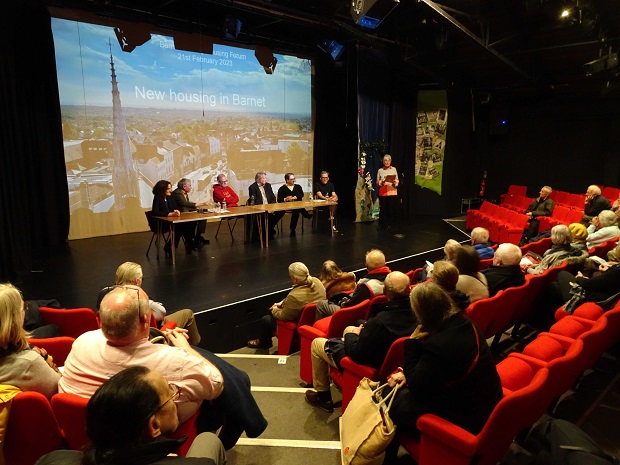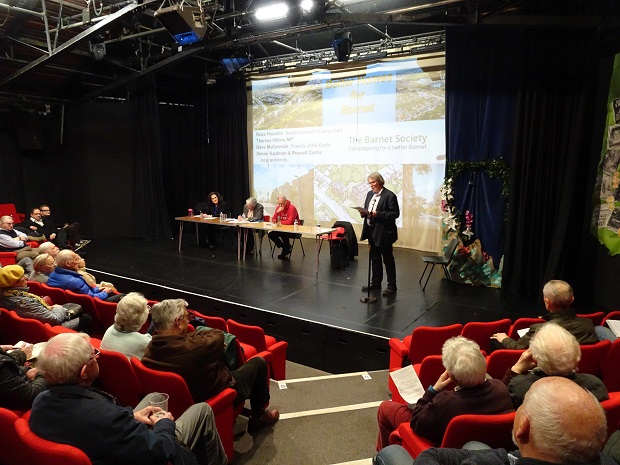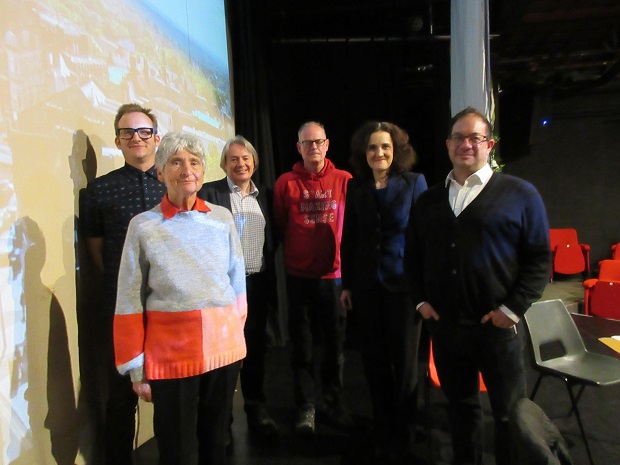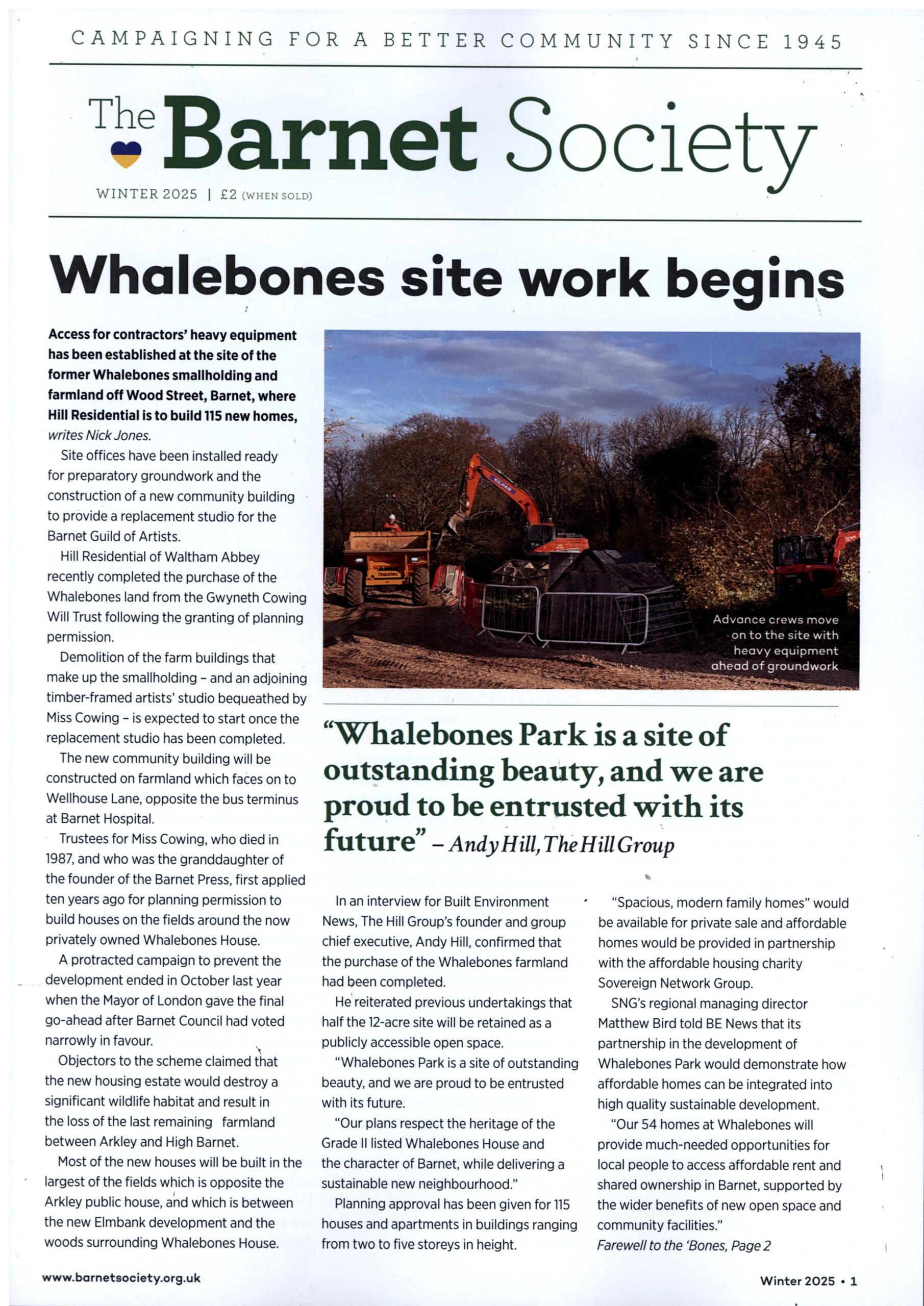Cross party unity on action needed to prevent spread of high-rise developments around Barnet

Action to thwart the onward advance of tower blocks around High Banet and close to the Green Belt was a shared objective of a panel of politicians and architects at a Barnet Society discussion on future housing needs.
An audience of around 70 participated in a lively debate at The Bull theatre (21.2.2023) on how to achieve better housing for Barnet – the first public meeting held by the society since the Covid-19 pandemic.
Barnet Council, now under Labour control, was praised by the Chipping Barnet Conservative MP Theresa Villiers for the robust stance it was taking in opposing high-rise developments in suburban settings.
Ross Houston, chair of the housing and growth committee, told the meeting that the council would stand up to developers seeking to build tower blocks in the townships and villages in and around High Barnet.
These communities wanted more family and affordable homes rather than high-rise and the council had already given developers a “red card” in rejecting massive over development at the New Barnet gas works site and the North London Business Park.
Ms Villiers welcomed the council’s “continued scepticism” towards the construction of tall blocks of flats in the surrounding locality.
She hoped it would be possible for the political parties to work together to shape housing policies that were in tune with their neighbourhoods while the Borough of Barnet played its part in delivering a significant number of new homes.

Mr Houston (see above) explained why he believed that the council had gone “badly wrong” in recent years in not being pro-active at the start of the planning process in steering developers away from high-rise developments.
This would be addressed in future by a design review panel that would be established once planning is back under the council’s control in April, in line with the termination of the ten-year outsourcing contract between Barnet and Capita.
Whereas a future panel would have to take into account the design challenges of major redevelopments, such as the scheme for 10,000 homes at Cricklewood, the objective for the townships and villages on the outskirts of the borough would be to encourage low to medium street scape designs to reduce the number of tower blocks.
Mr Houston said the chair of the planning committee would be only too happy to work with groups like the Barnet Society and Barnet Residents Association in assembling a design review panel.
His offer to consult was welcomed by two architects who live in Barnet – Simon Kaufman and Russell Curtis who – who gave a presentation to illustrate the kind of housing projects that delivered good quality design.
Mr Curtis said that Barnet, along with Bromley, were the only two London boroughs currently without a design review panel. If one was established as promised by the council, he believed it would improve the quality of housing developments.
Without a “decent, well-funded panel” which had a grasp on issues like quality, high density and character, Barnet would continue to lack the means to make sure that developers were going in the right direction from the start of the planning process.
Ms Villiers agreed with the importance of good design, and she thanked the two architects for a presentation that had only served to underline her belief that a significant density of housing could be achieved in sensitive settings.
A failure to come up with proposals that were in tune with their neighbourhoods had been all too evident in New Barnet where there had now been a 14-year wait for an acceptable scheme for the Victoria Quarter development.
The failed attempt to get approval for the over-development of the gas works site reflected the pressure on local authorities to meet the excessively high housing targets that were being set by central government against which she had been campaigning at Westminster.
Consultations were now taking place on a new national planning policy framework that would give local authorities greater control over the number of homes to be built in their neighbourhoods.
When asked whether the new framework would tackle the problem of developers sitting on vacant sites to take advantage of rising land values, Ms Villiers said the Victoria Quarter was a pertinent example.
If the developers had acted on the planning permission granted in 2017, there would now be people living on the gas works site.

Speakers’ line-up for the debate (from left to right) Russel Curtis, Frances Wilson, chair, Barnet Society, Ross Houston, Dave McCormick, Theresa Villiers MP, Simon Kaufman
Call for environmental initiatives.
Building sustainable new homes and retrofitting older houses were two of the greatest challenges when it came to creating a healthier environment in Barnet,
Dave McCormick of the Barnet Friends of the Earth outlined the steps that would need to be taken to reduce emissions.
The majority of High Barnet’s housing stock was pre-war and the cost of retrofitting these properties was huge: 78 per cent had gas heating and housing was responsible for 48 per cent of Barnet’s emissions.
Each community should consider what steps could be taken to improve sustainability – and there was a myriad of unexpected opportunities.
For example, High Barnet’s annual Christmas fare could examine the possibility of using renewable energy to cut down on the number of diesel generators that are used to provide power for the fun fair, stalls, and caterers that line Barnet High Street on the first Sunday in December.
Mr McCormick said the organisers of this year’s East Finchley Festival in Cherry Tree Wood in June were hoping to use sustainable power sources such as batteries to reduce the pollution caused by diesel generators – an idea which Bob Burstow, secretary of the Chipping Barnet Town Team, said would be well worth examining when planning starts for the Christmas Fair next December.
1 thought on “Cross party unity on action needed to prevent spread of high-rise developments around Barnet”
Comments are closed.


An excellent meeting. It was heartening to hear that the age of the tower blocks might be ending. The alternative schemes that were presented by our local architects would be more friendly to our environment.